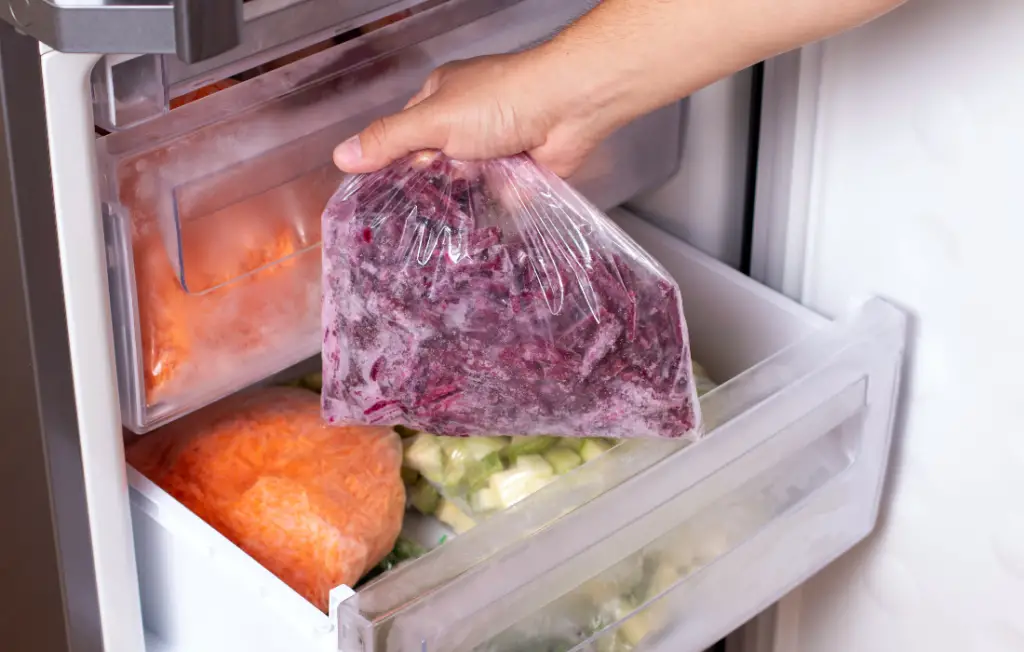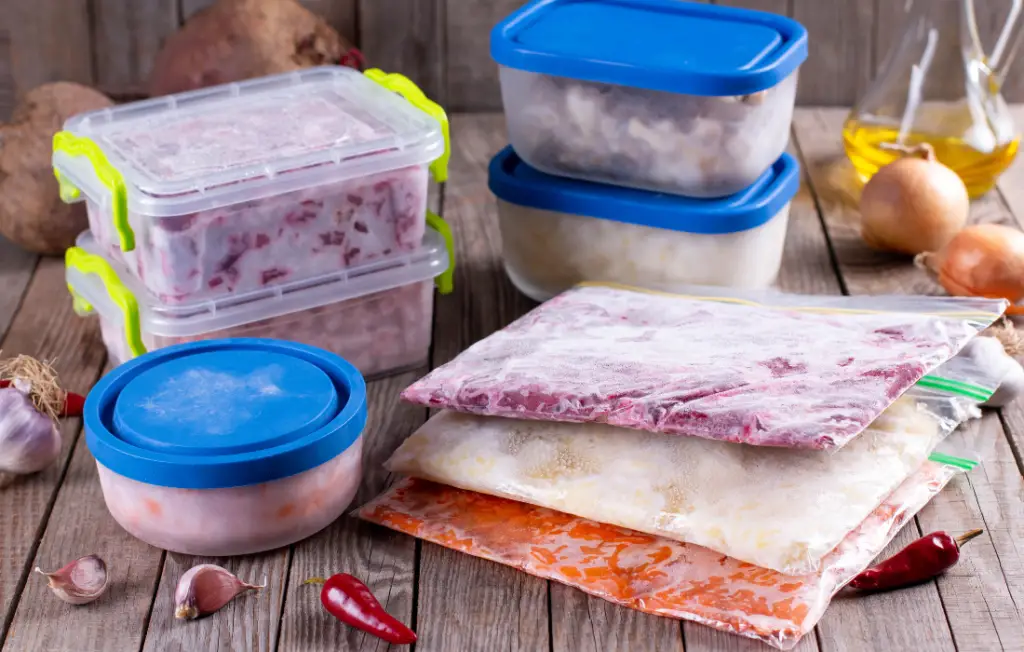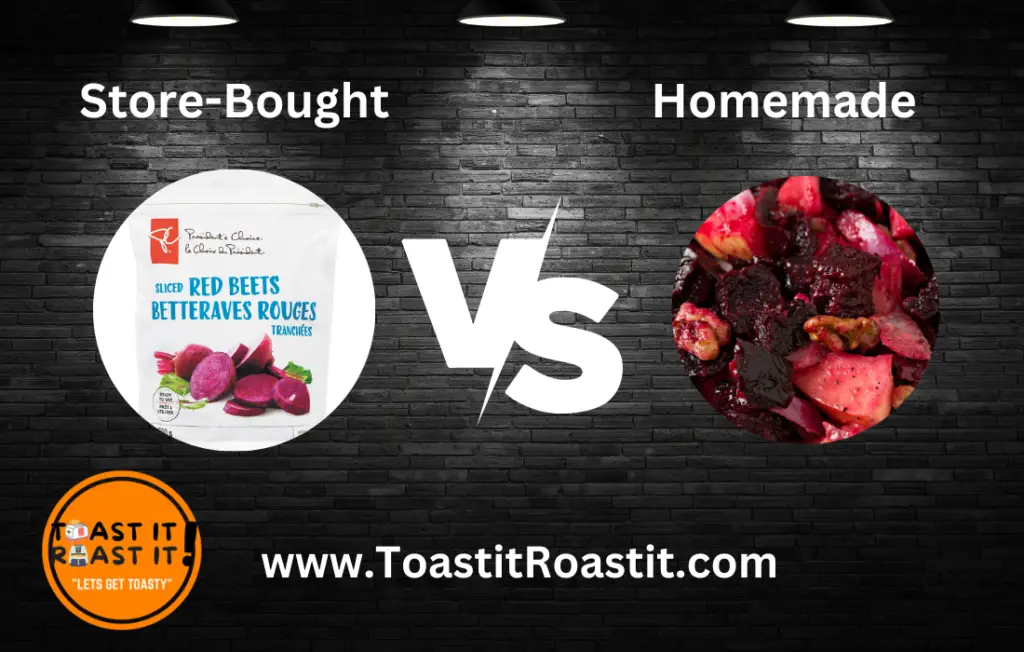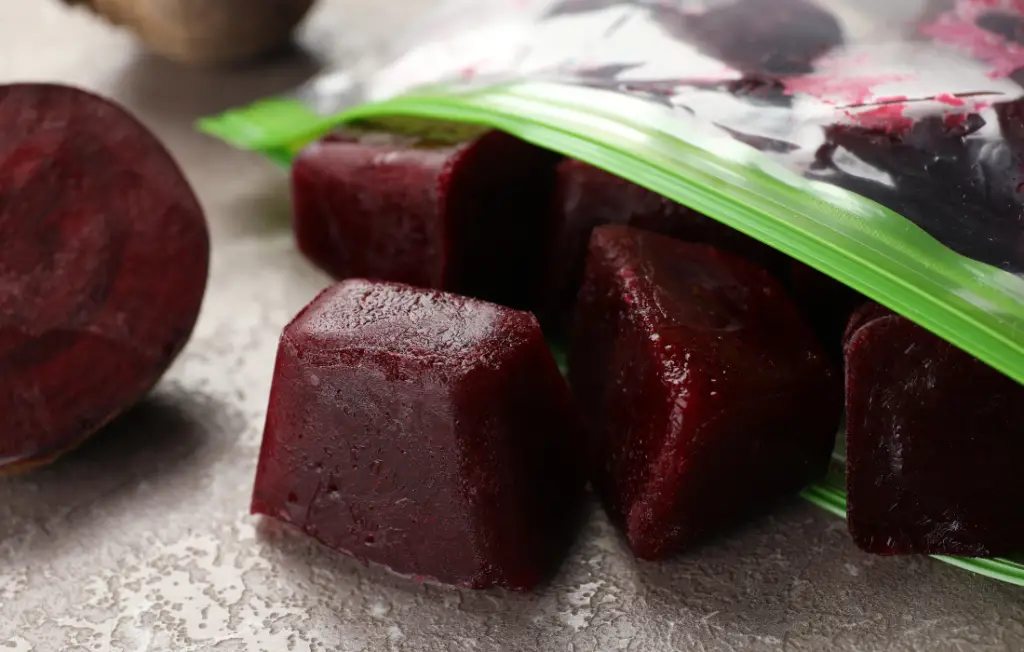Have you ever wondered, “Can you freeze roasted beets?” This vibrant, sweet, and earthy vegetable is a favorite in many dishes, but storing them properly to retain their unique flavor is essential.
Yes, you absolutely can freeze roasted beets. First, allow your roasted beets to cool completely after cooking. Then, individually wrap them in plastic wrap or place them in a single layer on a baking sheet and freeze. Once they’re fully frozen, transfer them to a sealed, freezer-safe bag or container for long-term storage.
In this comprehensive guide, we will dive into the nuances of freezing roasted beets, preserving their rich flavors, and expert tips for optimal long-term storage. We’ll provide insights from professional chefs, answers to frequently asked questions, and practical troubleshooting tips for perfect frozen roasted beets. So, join us as we explore this interesting facet of beet preservation.
- The Science Behind Freezing Roasted Beets
- 5 Step Guide to Freezing Roasted Beets
- How to Thaw and Use Frozen Roasted Beets
- 5 “Toasty” Troubleshooting Tips for Freezing and Thawing Beets
- Expert Insights: The Proper Way to Freeze Roasted Beets
- Preserving the Flavor of Roasted Beets – A Step-by-step Guide
- Store-Bought vs. Homemade: The Great Beet Debate
- The Case for Homemade Roasted Beets
- FAQs on Freezing Roasted Beets
- Key Takeaways: Freezing Roasted Beets for Long-Term Storage
- Conclusion
The Science Behind Freezing Roasted Beets
Freezing is a fascinating method of preserving food that has been in use for centuries. It works by slowing down the decomposition process caused by bacteria and enzymes present in food. When we freeze roasted beets, the low temperature slows down the activity of these microbes and enzymes, effectively preserving the beets’ flavor and nutritional value.

Beets are a powerhouse of nutrients, packed with vitamins, minerals, and potent antioxidants like betalains that give them their deep red color. Freezing, when done correctly, can preserve most of these nutrients. While there might be a minimal loss of some heat-sensitive vitamins like vitamin C during the roasting process, most nutrients remain intact even after freezing.
Let’s examine the nutritional value of roasted beets before and after freezing:
| Nutrient | Roasted Beets (Per 100g) | Frozen Roasted Beets (Per 100g) |
|---|---|---|
| Calories | 44 Kcal | 42 Kcal |
| Protein | 1.7g | 1.6g |
| Fat | 0.2g | 0.2g |
| Carbohydrates | 10g | 9.5g |
| Fiber | 2g | 1.9g |
| Vitamin C | 3.6mg | 3.1mg |
| Iron | 0.8mg | 0.7mg |
| Calcium | 16mg | 15mg |
The slight decrease in nutrient content is not significant enough to deter the benefits of freezing. Thus, freezing roasted beets remains an effective way to extend their shelf life while retaining most of their nutritional profile.
5 Step Guide to Freezing Roasted Beets
Alright, beet lovers, here’s the inside scoop – freezing roasted beets can be as easy as pie! You just need to follow a few crucial steps to keep those sweet, earthy treats tasting fresh off the oven, even after months in the cold. Let’s get beet-zy, shall we?
Step 1: Cool Your Beets (Literally)
Once you’ve roasted your beets, take a chill pill. Let your beets cool down completely at room temperature before freezing. We don’t want them sweating in the freezer and getting freezer burn, do we?
Step 2: Individual Freezing is Key
Next, arrange your cooled beets in a single layer on a baking sheet. Make sure they aren’t touching. We want them to freeze individually first, so they don’t end up like conjoined beet triplets in the freezer.
Step 3: The Initial Freeze
Slide the baking sheet into the freezer and let the beets have a good, solid freeze. This should take about 2 hours, just enough time for you to binge-watch a few episodes of your favorite cooking show!
Step 4: Packaging for the Long Haul
After the beets are fully frozen, it’s time for packing! You can use freezer bags or airtight containers. Remember, squeeze out as much air as you can from the bags before sealing them. For containers, leave a little headspace for expansion. Don’t forget to label and date!
Step 5: The Final Freeze
Pop the packaged beets back into the freezer for their extended chilly vacation. They’re now ready for long-term storage and can be used whenever you crave that roasted beet goodness!
And there you have it, a quick 5-step guide to freezing your roasted beets like a pro. Happy beet freezing!
How to Thaw and Use Frozen Roasted Beets
Frozen roasted beets, ready at your disposal, can be a true lifesaver on those hectic days or when you’re looking for a quick flavor boost to your salads, soups, or sides. But, how do we transition them from icy nuggets to tender, flavorful treats? Let’s get to it.

Thawing the Beets
The best way to thaw your frozen roasted beets is to let nature do its thing. Simply transfer the desired amount of beets from the freezer to the refrigerator and let them slowly come back to life overnight. This helps maintain the texture and doesn’t encourage bacteria growth, which can happen if left to thaw at room temperature.
Emergency Thawing
In a bit of a rush? You can use the defrost function on your microwave, but proceed with caution. Defrost in short bursts and check the beets frequently to ensure they don’t start cooking.
Using Thawed Roasted Beets
Once your roasted beets are thawed, they are ready to roll! You can eat them cold straight from the fridge – they make a delicious addition to salads. For warm dishes, consider giving them a quick sauté in a pan or a brief visit to the oven to revive their roasted goodness. They can jazz up a humble soup, complement a hearty stew, or stand alone as a delicious side dish.
And remember, if you have thawed more beets than you need, it’s best to use them up within 48 hours. That’s a perfect excuse to indulge in some beet goodness! Thaw, taste, and treasure – enjoy your frozen roasted beets at their best!
Print
Can you freeze roasted beets?
A simple and convenient way to extend the life of your favorite roasted beets. Freezing preserves their earthy and sweet flavor, making them a ready-to-use addition to your meals whenever you want.
- Total Time: 10 minutes
- Yield: Depends on the number of beets frozen
Ingredients
Roasted beets (as many as you’d like to freeze)
Instructions
- Let the roasted beets cool completely after cooking.
- Individually wrap each beet in cling film or aluminum foil.
- Place the wrapped beets in a freezer-safe bag or an airtight container.
- Leave a bit of space for the beets to expand when they freeze.
- Label and date your package before storing it in the freezer.
- When ready to use, thaw your frozen beets in the refrigerator.
- For best flavor, consider reheating your thawed beets in the oven or sautéing them in a pan.
Notes
- For best flavor and texture, use your frozen roasted beets within six months.
- Rapid thawing can lead to a mushy texture. Thaw your beets slowly in the refrigerator for best results.
- Prep Time: 10 minutes (after roasted beets have cooled)
- Cook Time: 0 minutes
- Category: Food Preservation
- Method: Freezing
- Cuisine: Any
- Diet: Vegan
5 “Toasty” Troubleshooting Tips for Freezing and Thawing Beets
Alright beet aficionados, we’ve covered the basics, but let’s not beet around the bush. Sometimes, freezing and thawing can have its challenges. So, let’s peel back some layers and address some common hiccups you might encounter along the way with our “toasty” troubleshooting tips.
1. Icy Situation: Freezer Burn
You find your beets covered in ice crystals, looking a bit like a snowman’s nose on a chilly morning. This is freezer burn, and it usually happens when air gets to your beets in the freezer. Make sure you’re using air-tight containers or bags and squeezing out as much air as possible.
2. Stuck Together: Beets Block
If your beets are frozen together like a choir in mid-song, you skipped the individual freezing step. Remember, first freeze them spread out on a baking tray before packing.
3. Mushy Mess: Texture Loss
If your thawed beets are as soft as a love song, it’s likely because they were thawed too quickly. Rapid temperature changes can lead to a mushy texture. Next time, let them thaw overnight in the refrigerator.
4. Reduced Flavor: Taste Change
If your thawed beets are lacking their usual sweet and earthy punch, they might have been in the freezer for too long. While beets can last in the freezer for up to a year, for the best flavor, aim to use them within six months.
5. Color Changes: Not-So-Red Beets
Are your beets looking a little less vibrant after freezing? Don’t worry; this is normal. The freezing and thawing process might slightly alter the color, but it doesn’t affect the taste or nutritional content.
Remember, every beet deserves a chance to shine, even if it’s been frozen and thawed. With these troubleshooting tips, you’re well equipped to handle any beet situation that comes your way!
Expert Insights: The Proper Way to Freeze Roasted Beets
Preserving the rich, earthy flavor of roasted beets through freezing can be a culinary game-changer. Here are ten tips from professional chefs and food experts on how to properly freeze your roasted beets:
- Allow to Cool: After roasting your beets, let them cool completely before freezing to prevent condensation, which can lead to freezer burn.
- Individual Freezing: Freeze the beets individually on a tray before transferring them into bags. This prevents them from sticking together.
- Portion Control: Freeze beets in serving-size portions for easy thawing and cooking later.
- Use Quality Containers: Use good-quality, airtight, freezer-safe containers or bags to prevent freezer burn and flavor loss.
- Label and Date: Don’t forget to label and date your frozen beets. They can last up to a year in the freezer, but are best used within six months.
- Seal Well: Ensure your containers or bags are sealed well to prevent air from getting in.
- Don’t Overfill: Leave some space in your bags or containers to allow for expansion as the beets freeze.
- Quick Freeze: For preserving the flavor and texture, freeze the beets as quickly as possible after cooling.
- Thaw Properly: When ready to use, thaw your beets in the fridge overnight to maintain the best texture and flavor.
- Revive Flavor: Once thawed, consider tossing your beets in a bit of olive oil and roasting for a few minutes to revive their flavor.
Comparison of different freezing methods:
| Freezing Method | Pros | Cons |
|---|---|---|
| Freezer Bag | Easy to store, affordable | Requires more time to freeze, risk of freezer burn |
| Vacuum Sealing | Best for long-term storage, less risk of freezer burn | Requires special equipment, more expensive |
| Airtight Containers | Reusable, good for short-term storage | Takes up more space in the freezer |
With these expert insights and techniques, you can master the art of freezing roasted beets, keeping them on hand for when you need that perfect addition to your meals.
Preserving the Flavor of Roasted Beets – A Step-by-step Guide
We all love the earthy, sweet taste of roasted beets, and the desire to keep that flavor locked in is real. So, let’s explore a step-by-step guide on how to properly store your roasted beets, ensuring that delectable flavor doesn’t beat a hasty retreat!

Step 1: Cool Down Time
Patience, my friends! After roasting, give your beets some chill time to cool down completely. This prevents condensation (which leads to sogginess) when you store them.
Step 2: The Right Wrapping
Now, wrap each beet individually in cling film or aluminum foil. This step creates a protective layer around your beet, preserving its flavor and texture.
Step 3: Choose Your Container
Next, choose an airtight container or a freezer-safe bag to store your wrapped beets. These protect your beets from the harsh freezer environment and keep them flavor-packed.
Step 4: Room for Expansion
When packing the beets, leave some space in the container or bag for the beets to expand a little as they freeze. We don’t want any beet casualties due to a space crunch, do we?
Step 5: Label, Date, and Freeze
Don’t forget to label and date your package before popping it into the freezer. This way, you’ll remember when you froze them and use them at their prime.
Step 6: Slow and Steady Thaw
When it’s time to use your frozen beets, transfer them from the freezer to the fridge and let them thaw slowly and naturally. This method maintains their texture and helps preserve their flavor.
Step 7: Reheat and Eat
To unlock the maximum flavor, consider reheating your thawed beets. A quick toss in a hot oven or pan can bring back that “just-roasted” taste we all love.
Follow these steps, and you’ll be enjoying the delicious flavor of your roasted beets, whether it’s been a day, a week, or a few months since you made them. Here’s to a beet-iful time in your kitchen!
Store-Bought vs. Homemade: The Great Beet Debate
There’s been quite the debate raging in the culinary world, and it’s all about beets. On one side of the argument, we have store-bought, pre-roasted and possibly even pre-cut beets. On the other, there are homemade roasted beets, fresh from your oven and prepared with love. How do these two options stack up against each other, and which should you choose for freezing? Let’s dig in.
The Case for Store-Bought Beets
Let’s face it, store-bought beets are convenient. They’re already roasted, saving you precious time and effort. If you’re busy, or if roasting beets isn’t quite your thing, these could be a great option.
On the flip side, store-bought beets may come with additives or preservatives that might affect their taste. Moreover, you don’t have control over the freshness of the beets or the way they’re roasted.
Pros and Cons of Store-Bought Beets
| Pros | Cons |
|---|---|
| Convenient | May contain additives or preservatives |
| Saves time and effort | Less control over freshness and roasting method |
The Case for Homemade Roasted Beets
Homemade roasted beets, on the other hand, are as fresh as they come. You have complete control over the type of beets you use, how they’re roasted, and when you freeze them. They’re perfect for those who enjoy spending a little time in the kitchen.

However, they do require some effort and planning. You’ll need to buy fresh beets, roast them, and allow them to cool before freezing.
Comparison table: Pros and Cons of Homemade Roasted Beets
| Pros | Cons |
|---|---|
| Fresh | Require more time and effort |
| Complete control over the process | Need planning |
So, which one should you choose for freezing? The answer depends on your preferences and lifestyle. If you prefer convenience, go for store-bought. If freshness and control over the process are more important, homemade is the way to go. Whatever you choose, happy beet freezing!
FAQs on Freezing Roasted Beets
When it comes to freezing roasted beets, we know you’ve got some burning questions. Let’s get down to the “root” of these queries with our FAQ section, pulling from the “People also asked” section. Get ready for some beet-tastic revelations!
Do roasted beets freeze well?
Yes, they do! When properly frozen, roasted beets can retain their earthy flavor and nutrition. It’s like having fresh-from-the-oven beets ready on demand!
How long do roasted beets last in the freezer?
Roasted beets can last up to a year in the freezer. However, for the best flavor and texture, it’s recommended to use them within six months.

Can you eat thawed roasted beets cold?
Absolutely! Thawed roasted beets are great in salads or as a cold side dish. Just remember to thaw them properly in the refrigerator.
How can you revive the flavor of thawed roasted beets?
Consider giving thawed beets a quick toss in a hot oven or sautéing them in a pan. This can awaken their roasted flavor and give them a little crispiness.
Can you refreeze thawed roasted beets?
It’s not recommended to refreeze thawed beets as this can lead to a mushy texture and flavor loss. Try to only thaw what you’ll use.
Here’s a handy table summarizing these quick beet bites:
| FAQ | Quick Answer |
|---|---|
| Do roasted beets freeze well? | Yes |
| How long do roasted beets last in the freezer? | Up to a year, best within 6 months |
| Can you eat thawed roasted beets cold? | Yes |
| How to revive the flavor of thawed roasted beets? | Reheat in oven or sauté |
| Can you refreeze thawed roasted beets? | Not recommended |
With these FAQs under your belt, you’re ready to conquer the world of freezing roasted beets. Beet-tastic!
Key Takeaways: Freezing Roasted Beets for Long-Term Storage
Phew, we’ve covered quite some ground on our beet-freezing journey, haven’t we? As we wrap up, let’s take a moment to reflect on our beet-tastic voyage and distill the major points we’ve picked up along the way.
Freezing is Friendly: Yes, roasted beets can indeed be frozen, and they freeze quite well. This method locks in the flavor and nutritional value, making it a great way to extend the life of your roasted beets.
Proper Preparation is Key: From letting the beets cool before freezing to individually freezing them on a baking sheet, the right prep steps go a long way in ensuring the quality of your frozen beets.
Storage Matters: Using airtight containers or freezer bags, labeling, and dating your packages not only keep things organized but also prevent dreaded freezer burn.

Thawing Technique: The best way to thaw your frozen beets is in the refrigerator. It’s slow, yes, but it helps maintain their texture and taste.
Reviving Roasted Beets: A quick sauté or toss in the oven can rekindle the delicious roasted flavor of your thawed beets.
Handling Hiccups: From freezer burns to color changes, we’ve explored common issues that might crop up while freezing and thawing beets. But now, you’re armed with ‘toasty’ tips to troubleshoot these issues like a pro.
Freezing roasted beets doesn’t have to be a daunting task. With these key takeaways, you’re now well-equipped to enjoy the goodness of roasted beets anytime you please. So, here’s to enjoying beets all year round. Stay cool and keep beet-ing!
Conclusion
In this journey of freezing roasted beets, we’ve covered quite the expanse, from the science behind freezing to the actual practice, expert tips, common hiccups, and FAQ’s. Now you’re equipped with everything you need to make your roasted beets last and serve up their hearty, earthy goodness on demand, whenever the craving strikes.
Remember, the process of freezing is not a beat-the-clock game; patience is key here. And while these steps might feel a little tedious at first, the reward of being able to pull out ready-to-use roasted beets from your freezer at a moment’s notice is well worth it.
So, go ahead and give it a shot, and relish in the joy of having your favorite roasted beets available at your fingertips, whenever you want. Happy freezing, thawing, and of course, eating! Stay beet-iful!

